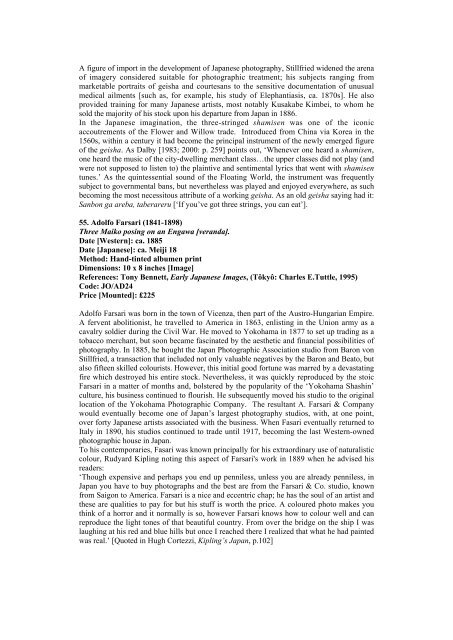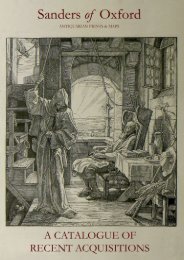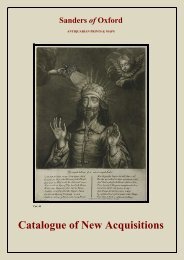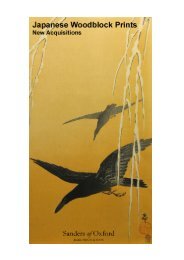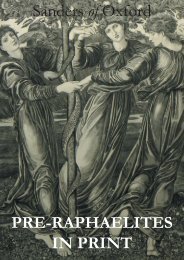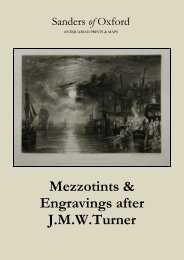Create successful ePaper yourself
Turn your PDF publications into a flip-book with our unique Google optimized e-Paper software.
A figure <strong>of</strong> import in the development <strong>of</strong> Japanese photography, Stillfried widened the arena<br />
<strong>of</strong> imagery considered suitable for photographic treatment; his subjects ranging from<br />
marketable portraits <strong>of</strong> geisha and courtesans to the sensitive documentation <strong>of</strong> unusual<br />
medical ailments [such as, for example, his study <strong>of</strong> Elephantiasis, ca. 1870s]. He also<br />
provided training for many Japanese artists, most notably Kusakabe Kimbei, to whom he<br />
sold the majority <strong>of</strong> his stock upon his departure from Japan in 1886.<br />
In the Japanese imagination, the three-stringed shamisen was one <strong>of</strong> the iconic<br />
accoutrements <strong>of</strong> the Flower and Willow trade. Introduced from China via Korea in the<br />
1560s, within a century it had become the principal instrument <strong>of</strong> the newly emerged figure<br />
<strong>of</strong> the geisha. As Dalby [1983; 2000: p. 259] points out, ‘Whenever one heard a shamisen,<br />
one heard the music <strong>of</strong> the city-dwelling merchant class…the upper classes did not play (and<br />
were not supposed to listen to) the plaintive and sentimental lyrics that went with shamisen<br />
tunes.’ As the quintessential sound <strong>of</strong> the Floating World, the instrument was frequently<br />
subject to governmental bans, but nevertheless was played and enjoyed everywhere, as such<br />
becoming the most necessitous attribute <strong>of</strong> a working geisha. As an old geisha saying had it:<br />
Sanbon ga areba, taberareru [‘If you’ve got three strings, you can eat’].<br />
55. Adolfo Farsari (1841-1898)<br />
Three Maiko posing on an Engawa [veranda].<br />
Date [Western]: ca. 1885<br />
Date [Japanese]: ca. Meiji 18<br />
Method: Hand-tinted albumen print<br />
Dimensions: 10 x 8 inches [Image]<br />
References: Tony Bennett, Early Japanese Images, (Tôkyô: Charles E.Tuttle, 1995)<br />
Code: JO/AD24<br />
Price [Mounted]: £225<br />
Adolfo Farsari was born in the town <strong>of</strong> Vicenza, then part <strong>of</strong> the Austro-Hungarian Empire.<br />
A fervent abolitionist, he travelled to America in 1863, enlisting in the Union army as a<br />
cavalry soldier during the Civil War. He moved to Yokohama in 1877 to set up trading as a<br />
tobacco merchant, but soon became fascinated by the aesthetic and financial possibilities <strong>of</strong><br />
photography. In 1885, he bought the Japan Photographic Association studio from Baron von<br />
Stillfried, a transaction that included not only valuable negatives by the Baron and Beato, but<br />
also fifteen skilled colourists. However, this initial good fortune was marred by a devastating<br />
fire which destroyed his entire stock. Nevertheless, it was quickly reproduced by the stoic<br />
Farsari in a matter <strong>of</strong> months and, bolstered by the popularity <strong>of</strong> the ‘Yokohama Shashin’<br />
culture, his business continued to flourish. He subsequently moved his studio to the original<br />
location <strong>of</strong> the Yokohama Photographic Company. The resultant A. Farsari & Company<br />
would eventually become one <strong>of</strong> Japan’s largest photography studios, with, at one point,<br />
over forty Japanese artists associated with the business. When Fasari eventually returned to<br />
Italy in 1890, his studios continued to trade until 1917, becoming the last Western-owned<br />
photographic house in Japan.<br />
To his contemporaries, Fasari was known principally for his extraordinary use <strong>of</strong> naturalistic<br />
colour, Rudyard Kipling noting this aspect <strong>of</strong> Farsari's work in 1889 when he advised his<br />
readers:<br />
‘Though expensive and perhaps you end up penniless, unless you are already penniless, in<br />
Japan you have to buy photographs and the best are from the Farsari & Co. studio, known<br />
from Saigon to America. Farsari is a nice and eccentric chap; he has the soul <strong>of</strong> an artist and<br />
these are qualities to pay for but his stuff is worth the price. A coloured photo makes you<br />
think <strong>of</strong> a horror and it normally is so, however Farsari knows how to colour well and can<br />
reproduce the light tones <strong>of</strong> that beautiful country. From over the bridge on the ship I was<br />
laughing at his red and blue hills but once I reached there I realized that what he had painted<br />
was real.’ [Quoted in Hugh Cortezzi, Kipling’s Japan, p.102]


